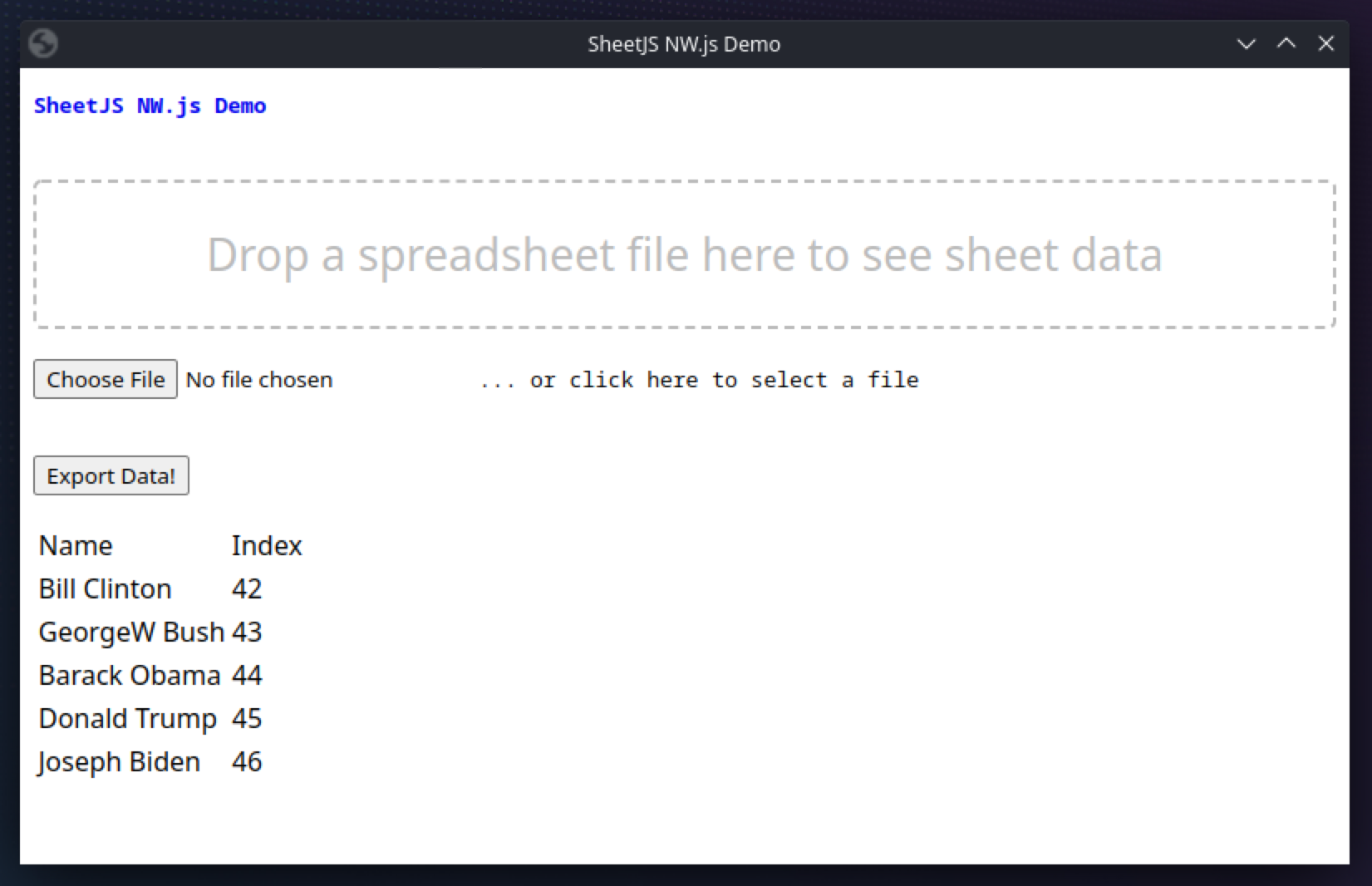Sheets in NW.js
NW.js, formerly node-webkit, is a modern toolkit for
building desktop apps using web technologies.
SheetJS is a JavaScript library for reading and writing data from spreadsheets.
The "Complete Example" section covers a complete desktop app to read and write workbooks. The app will look like the screenshots below:
| Windows | macOS | Linux |
|---|---|---|
|
|
|
Integration Details
The SheetJS Standalone scripts
can be referenced in a SCRIPT tag from the entry point HTML page.
NW.js provides solutions for reading and writing files.
Reading Files
The standard HTML5 FileReader techniques from the browser apply to NW.js!
NW.js handles the OS minutiae for dragging files into app windows. The drag and drop snippet apply to DIV elements on the page.
Similarly, file input elements automatically map to standard Web APIs.
For example, assuming a file input element on the page:
<input type="file" name="xlfile" id="xlf" />
The event handler would process the event as if it were a web event:
async function handleFile(e) {
const file = e.target.files[0];
const data = await file.arrayBuffer();
/* data is an ArrayBuffer */
const workbook = XLSX.read(data);
/* DO SOMETHING WITH workbook HERE */
}
document.getElementById("xlf").addEventListener("change", handleFile, false);
Writing Files
File input elements with the attribute nwsaveas show UI for saving a file. The
standard trick is to generate a hidden file input DOM element and "click" it.
Since NW.js does not present a writeFileSync in the fs package, a manual
step is required:
/* pre-build the hidden nwsaveas input element */
var input = document.createElement('input');
input.style.display = 'none';
input.setAttribute('nwsaveas', 'SheetJSNWDemo.xlsx');
input.setAttribute('type', 'file');
document.body.appendChild(input);
/* show a message if the save is canceled */
input.addEventListener('cancel',function(){ alert("Save was canceled!"); });
/* write to a file on the 'change' event */
input.addEventListener('change',function(e){
/* the `value` is the path that the program will write */
var filename = this.value;
/* use XLSX.write with type "buffer" to generate a buffer" */
var wbout = XLSX.write(workbook, {type:'buffer', bookType:"xlsx"});
require("fs").writeFile(filename, wbout, function(err) {
if(!err) return alert("Saved to " + filename);
alert("Error: " + (err.message || err));
});
});
input.click();
Complete Example
This demo was tested in the following environments:
| OS and Version | Architecture | NW.js | Date | Notes |
|---|---|---|---|---|
| macOS 15.3.2 | darwin-x64 | 0.94.0 | 2025-03-31 | |
| macOS 14.5 | darwin-arm | 0.94.0 | 2025-03-30 | |
| Windows 11 | win11-x64 | 0.100.0 | 2025-05-27 | |
| Windows 11 | win11-arm | 0.94.0 | 2025-02-23 | |
| Linux (Ubuntu) | linux-x64 | 0.101.2 | 2025-07-06 | |
| Linux (Debian) | linux-arm | 0.60.0 | 2025-02-16 | Unofficial build1 |
- Create a project folder:
mkdir sheetjs-nwjs
cd sheetjs-nwjs
- Create a
package.jsonfile that specifies the entry point:
{
"name": "sheetjs-nwjs",
"author": "sheetjs",
"version": "0.0.0",
"main": "index.html",
"dependencies": {
"nw": "0.101.2",
"xlsx": "https://cdn.sheetjs.com/xlsx-0.20.3/xlsx-0.20.3.tgz"
}
}
- Download
index.htmlinto the same folder.
Right-click the link and select "Save Link As...". Left-clicking the link will try to load the page in your browser. The goal is to save the file contents.
In the terminal window, the download can be performed with:
curl -LO https://docs.sheetjs.com/nwjs/index.html
In PowerShell, the command may fail with a parameter error:
Invoke-WebRequest : A parameter cannot be found that matches parameter name 'L'.
curl.exe must be invoked directly:
curl.exe -LO https://docs.sheetjs.com/nwjs/index.html
- Install dependencies:
npm i
- To verify the app works, run in the test environment:
npx nw .
On launch, the app will fetch and parse https://docs.sheetjs.com/pres.numbers .
Using the file input element, a file can be selected from the filesystem and the table will refresh with the contents of the selected file.
Click "Export Data!" and save the generated file to SheetJSNWDemo.xlsx. This
file can be opened in Excel or another spreadsheet editor.
Linux ARM64 support (click to show)
NW.js does not officially support linux-arm. The official recommendation is to
use a third-party pre-built version.
curl -LO https://github.com/LeonardLaszlo/nw.js-armv7-binaries/releases/download/nw60-arm64_2022-01-08/nw60-arm64_2022-01-08.tar.gz
tar -xzf nw60-arm64_2022-01-08.tar.gz
cp usr/docker/dist/nwjs-chromium-ffmpeg-branding/nwjs-v0.60.1-linux-arm64.tar.gz
tar -xzf nwjs-v0.60.1-linux-arm64.tar.gz
./nwjs-v0.60.1-linux-arm64/nw .
Unfortunately nw-builder will not be able to build a standalone program.
- To build a standalone app, run the builder:
npx -p [email protected] nwbuild --mode=build --version=0.101.2 --glob=false --outDir=../out ./
This will generate the standalone app in the ..\out\ folder.
There is a regression in nw-builder versions 4.12.0 and 4.13.14.
In local win11-x64 testing, 4.11.6 generates the standalone application.
npx -p [email protected] nwbuild --mode=build --version=0.101.2 --glob=false --outDir=../out ./
- Launch the generated application:
| Architecture | Command |
|---|---|
darwin-x64 | open ../out/sheetjs-nwjs.app |
darwin-arm | open ../out/sheetjs-nwjs.app |
win11-x64 | ..\out\sheetjs-nwjs.exe |
win11-arm | ..\out\sheetjs-nwjs.exe |
linux-x64 | ../out/sheetjs-nwjs |
Footnotes
-
The
nw60-arm64_2022-01-08release included an ARM64 version ofnw. ↩


